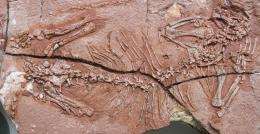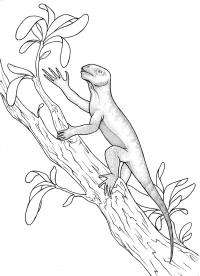How does this grab you? Study identifies first ancestor with a 'grasping hand'

In the Late Paleozoic (260 million years ago), long before dinosaurs dominated the Earth, ancient precursors to mammals took to the trees to feed on leaves and live high above predators that prowled the land, Jörg Fröbisch, PhD, a Field Museum paleontologist has concluded. Elongated fingers, an opposable "thumb," and a grasping tail of Suminia getmanovi demonstrate that this small plant-eating synapsid is the earliest known tree-climbing vertebrate
Suminia was relatively small, about 20 inches from its nose to the tip of its tail. The tree-climbing lifestyle of this Paleozoic relative of mammals is particularly important because for the first time in vertebrate evolution it gives access to new food resources high off the ground, and also provides protection from ground-dwelling predators. The evidence for this lifestyle is based on several excellent skulls and more than a dozen exceptionally well preserved, complete skeletons from a single large block of red mudstone that was discovered in central Russia's Kirov region.
Having so many individual specimens, some of mature individuals and some of youngsters, was helpful in providing a complete picture of the animal's skeletal anatomy, said Fröbisch. "It's relatively rare to find several animals locked on a single block," he said. "We have examples of virtually every bone in their bodies."
Finding that vertebrates took to trees so early in Earth's evolution was unexpected. "It's a surprise, but it makes sense," Fröbisch said. "It was a new niche for vertebrates. There was food available and they avoided predators on the ground."

The study also provides the first evidence in the fossil record of food partitioning between small climbing and large ground-dwelling plant-eaters and this happens shortly after the establishment of the modern terrestrial ecosystem with large numbers of plant-eaters supporting few top predators. Earlier terrestrial vertebrate communities did not have this modern hierarchy, but instead were composed of various-sized predators and relatively few plant-eaters, with most of the food resources being provided by insects and aquatic organisms.
More information: This research is part of a collaborative study of the first author Dr. Jörg Fröbisch (Department of Geology, Field Museum, Chicago) and Dr. Robert Reisz (Department of Biology, University of Toronto), which will be published on July 29 in the Proceedings of the Royal Society B.
Source: Field Museum


















